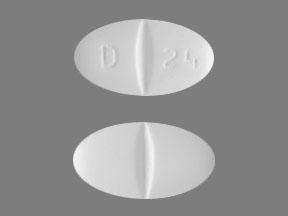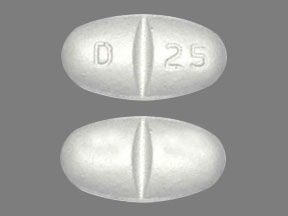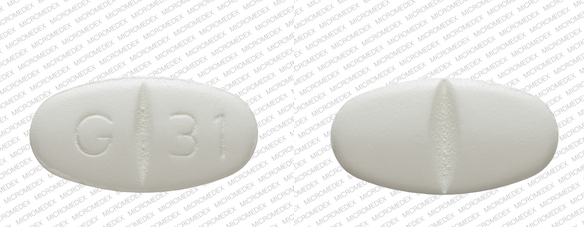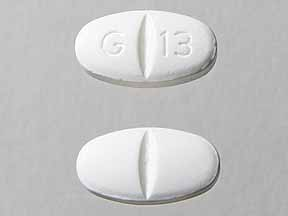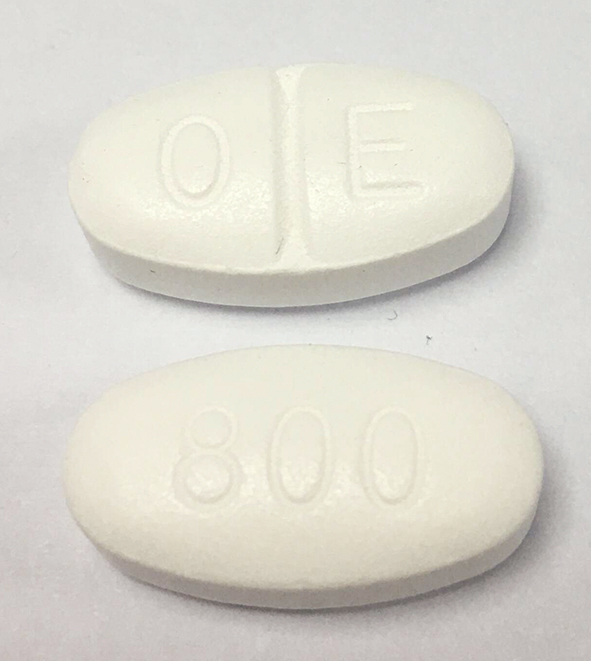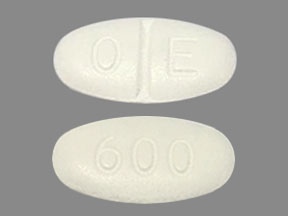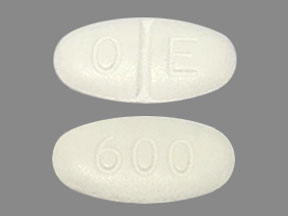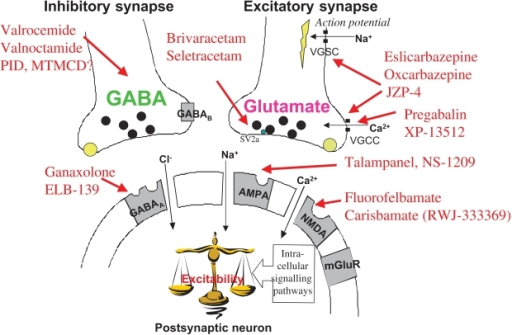Usual Adult Dose for Epilepsy
Initial dose: 300 mg orally on day one, 300 mg orally 2 times day on day two, then 300 mg orally 3 times a day on day three
Maintenance dose: 300 to 600 mg orally 3 times a day
Maximum dose: 3600 mg orally daily (in 3 divided doses)
-Maximum time between doses in the 3 times a day schedule should not exceed 12 hours
-The safety and effectiveness of gabapentin available under the trade name Gralise (R) or Horizant (R) in patients with epilepsy has not been studied.
Comment:
-May be taken with or without food.
-Half-tablets not used within 28 days of breaking the scored tablet should be discarded.
Use: Adjunctive therapy in the treatment of partial onset seizures, with and without secondary generalization
Usual Adult Dose for Postherpetic Neuralgia
-Initial dose: 300 mg orally on day one, 300 mg orally 2 times day on day two, then 300 mg orally 3 times a day on day three
-Titrate up as needed for pain relief
-Maximum dose: 1800 mg per day (600 mg orally 3 times a day)
COMMENT:
-May be taken with or without food.
-Half-tablets not used within 28 days of breaking the scored tablet should be discarded.
Gabapentin available under the trade name GRALISE (R):
-Maintenance dose: Gralise (R) should be titrated to 1800 mg orally once daily with the evening meal.
-Recommended titration schedule:
Day 1: 300 mg orally with the evening meal
Day 2: 600 mg orally with the evening meal
Days 3 through 6: 900 mg orally with the evening meal
Days 7 through 10: 1200 mg orally with the evening meal
Days 11 through 14: 1500 mg orally with the evening meal
Day 15: 1800 mg orally with the evening meal
COMMENT:
-Gralise (R) is not interchangeable with other gabapentin products because of differing pharmacokinetic profiles that affect the frequency of administration.
Gabapentin enacarbil extended release tablets are available under the trade name HORIZANT (R):
-The recommended dosage is 600 mg orally 2 times a day. Therapy should be initiated at a dose of 600 mg orally in the morning for 3 days of therapy, then increased to 600 mg 2 times a day (1200 mg/day) on day four.
COMMENT:
Gabapentin enacarbil extended release tablets available under the trade name Horizant (R) and gabapentin are not interchangeable.
Use: Postherpetic neuralgia
Usual Adult Dose for Restless Legs Syndrome
Gabapentin enacarbil available under the trade name Horizant (R):
600 mg orally once daily with food at about 5 PM
Comment:
-May be taken with or without food.
Use: For the treatment of moderate-to-severe primary Restless Legs Syndrome (RLS) in adults
Usual Pediatric Dose for Epilepsy
Less than 3 years: Not recommended
Greater than or equal to 3 and less than 12 years:
Starting Dose: Ranges from 10 to 15 mg/kg/day in 3 divided doses
Effective Dose: Reached by upward titration over a period of approximately 3 days; the effective dose in patients 5 years of age and older is 25 to 35 mg/kg/day in divided doses (3 times a day). The effective dose in pediatric patients ages 3 and 4 years is 40 mg/kg/day and given in divided doses (3 times a day). Gabapentin may be administered as the oral solution, capsule, or tablet, or using combinations of these formulations. Dosages up to 50 mg/kg/day have been well tolerated in a long term clinical study. The maximum time interval between doses should not exceed 12 hours.
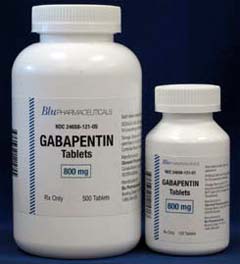
Greater than 12 years:
-Initial dose: 300 mg orally on day one, 300 mg orally 2 times a day on day two, then 300 mg orally 3 times a day on day three
-Maintenance dose: 900 to 1800 mg orally in 3 divided doses; the dose may be increased up to 1800 mg/day. Dosages up to 2400 mg/day have been well tolerated in long term clinical studies. Doses of 3600 mg/day have also been administered to a small number of patients for a relatively short duration, and have been well tolerated. The maximum time between doses in the three times a day schedule should not exceed 12 hours.
Use: Adjunctive therapy in the treatment of partial onset seizures, with and without secondary generalization in patients 3 years of age and older
Renal Dose Adjustments
For patients greater than or equal to 12 years:
-CrCl greater than 60 mL/min: 300 to 1200 mg orally 3 times a day
-CrCl 30 to 59 mL/min: 200 to 700 mg orally daily; increase to 600 mg as needed
-CrCl 15 to less than 29 mL/min: 200 to 700 mg orally once a day
-CrCl 15 mL/min: 100 to 300 mg orally every other day
-CrCl less than 15 mL/minute: Reduce daily dose in proportion to CrCl based on dose for CrCl 15 mL/minute (e.g., for a CrCl of 7.5 mL/min, reduce the daily dose by one-half to 50 to 150 mg/day)
-Hemodialysis: Dose based on CrCl plus a single supplemental dose of 125 to 350 mg given after each 4 hours of hemodialysis
-Use of this drug in patients less than 12 years of age with compromised renal function has not been studied.
The dose of gabapentin available under the trade name GRALISE (R) should be adjusted in patients with reduced renal function. Patients with reduced renal function should initiate GRALISE (R) at a daily dose of 300 mg. Daily dosing in patients with reduced renal function should be individualized based on tolerability and desired clinical benefit. GRALISE (R) should be titrated following the schedule outlined below:
Hemodialysis: Not recommended
CrCl less than 30 mL/min: Not recommended
CrCl 30 to 60 mL/min: 600 to 1800 mg orally with the evening meal
CrCl greater than or equal to 60 mL/min: 1800 mg orally with the evening meal
The dose of gabapentin enacarbil available under the trade name HORIZANT (R) should be adjusted in patients with reduced renal function as follows:
RESTLESS LEGS SYNDROME:
-CrCl less than 15 mL/min on hemodialysis: Not recommended
-CrCl less than 15 mL/min: 300 mg orally every other day
-CrCl 15 to 29 mL/min: 300 mg orally once a day
-CrCl 30 to 59 mL/min: Start at 300 mg orally daily and increase to 600 mg as needed
-CrCl greater than or equal to 60 mL/min: 600 mg orally once a day
POSTHERPETIC NEURALGIA:
-CrCl less than 15 mL/min on hemodialysis: 300 mg orally following every dialysis; increase to 600 mg orally following every dialysis if needed
-CrCl less than 15 mL/min: 300 mg orally every other day in the AM; increase to 300 mg orally once daily in the AM if needed
-CrCl 15 to 29 mL/min: 300 mg orally in the morning on day 1 and day 3 of therapy, then 300 mg once a day in the morning; may increase to 300 mg orally 2 times a day if needed; when tapering: if taking 300 mg orally 2 times a day, reduce to 300 mg orally once a day in the AM for 1 week; if taking 300 mg orally once a day no taper is needed
-CrCl 30 to 59 mL/min: 300 mg orally in the AM for 3 days, then 300 mg orally 2 times a day; increase to 600 mg orally 2 times a day as needed; when tapering: reduce current maintenance dose to once daily in the AM for 1 week
-CrCl greater than or equal to 60 mL/min: 600 mg orally in the morning for 3 days, then 600 mg orally 2 times a day thereafter; when tapering: 600 mg orally in the AM for 1 week
Liver Dose Adjustments
Data not available
Dose Adjustments
Because elderly patients are more likely to have decreased renal function, the dose of this drug should be adjusted based on CrCl values.
GRALISE (R):
-If the dose of this drug under the trade name Gralise (R) is reduced, discontinued, or substituted with an alternative medication, this should be done gradually over a minimum of 1 week or longer or as directed by the physician.
HORIZANT (R):
-If the dose of this drug available under the trade name Horizant (R) is discontinued, patients with RLS receiving 600 mg or less once daily can discontinue the drug without tapering. If the recommended dose is exceeded, the dose should be reduced to 600 mg daily for 1 week prior to discontinuation to minimize the potential of withdrawal seizure.
-Patients with PHN receiving Horizant (R) twice daily should reduce the dose to once daily for 1 week prior to discontinuation to minimize the potential for withdrawal seizure.
Precautions
-Safety and efficacy have not been established in patients younger than 18 years in the management of postherpetic neuralgia.
-Safety and efficacy have not been established in patients younger than 3 years in the adjunctive treatment of partial seizures.
-Safety and efficacy have not been established in patients younger than 18 years for gabapentin available under the trade names Gralise (R) or Horizant (R).
Consult WARNINGS section for additional precautions.
Dialysis
For patients greater than or equal to 12 years:
-Hemodialysis: Dose based on CrCl plus a single supplemental dose of 125 to 350 mg given after each 4 hours of hemodialysis
GRALISE (R): Hemodialysis: Not recommended
HORIZANT (R):
RESTLESS LEGS SYNDROME:
-CrCl less than 15 mL/min on hemodialysis: Not recommended
POSTHERPETIC NEURALGIA:
-CrCl less than 15 mL/min on hemodialysis: 300 mg orally following every dialysis; increase to 600 mg orally following every dialysis if needed
Other Comments
Administration advice:
-This drug may be given with or without food.
-Tablets should be swallowed whole and should not be cut, crushed, or chewed.
-Gabapentin enacarbil available under the trade name Horizant (R) should be taken with food.
-Gabapentin available under the trade name Gralise (R) should be taken with food with the evening meal.
-Gabapentin available under the trade names Gralise (R) and Horizant (R) should be swallowed whole, not crushed, split, or chewed.
General:
Horizant (R) and Gralise (R) are not interchangeable with other gabapentin products because of differing pharmacokinetic profiles.
-If gabapentin is discontinued and/or an alternate anticonvulsant medication is added to the therapy, this should be done gradually over a minimum of 1 week.
-Gabapentin available under the trade names Gralise (R) or Horizant (R) are not interchangeable with each other or with other gabapentin products.
